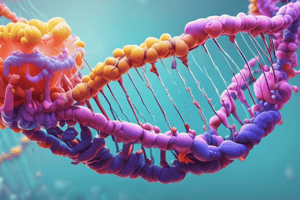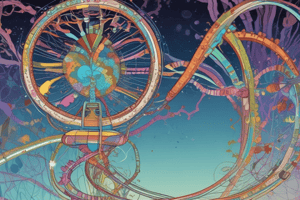Podcast
Questions and Answers
What is the primary focus of genetics?
What is the primary focus of genetics?
- The application of technologies to manipulate genetic material
- The study of heredity and variations in hereditary characteristics (correct)
- The study of the human genome and genetic technologies
- The study of environmental factors affecting gene expression
How do genomics and genetics differ in their focus?
How do genomics and genetics differ in their focus?
- Genomics focuses solely on protein coding genes.
- Genomics involves studying mutations in somatic cells only.
- Genetics studies individual traits while genomics looks at the whole genome. (correct)
- Genetics concentrates on external influences, whereas genomics is purely biological.
What does epigenetics primarily study?
What does epigenetics primarily study?
- The connection between genotype and phenotype due to environmental influences (correct)
- How chromosomal mutations affect inheritance patterns
- The sequence of amino acids in proteins
- The methods used in gene therapy for genetic diseases
What characterizes germline mutations?
What characterizes germline mutations?
Which option correctly distinguishes between somatic mutations and germline mutations?
Which option correctly distinguishes between somatic mutations and germline mutations?
What aspect of genetic conditions relates specifically to X-linked conditions?
What aspect of genetic conditions relates specifically to X-linked conditions?
Which mutation describes alterations in entire chromosomes?
Which mutation describes alterations in entire chromosomes?
Which statement best describes genomic mutations?
Which statement best describes genomic mutations?
What is the primary role of saliva in the mouth?
What is the primary role of saliva in the mouth?
Which layer of the GI tract is most involved in rapid cell turnover and has a higher chance of cancer development?
Which layer of the GI tract is most involved in rapid cell turnover and has a higher chance of cancer development?
What is true about the esophagus's muscle composition?
What is true about the esophagus's muscle composition?
Which structures in the esophagus help in preventing air from entering during respiration?
Which structures in the esophagus help in preventing air from entering during respiration?
How does the acidic content of the stomach affect the esophagus during GERD?
How does the acidic content of the stomach affect the esophagus during GERD?
What component of saliva provides lubrication during mastication?
What component of saliva provides lubrication during mastication?
Which of the following accurately describes the submucosa of the GI tract?
Which of the following accurately describes the submucosa of the GI tract?
What is the primary function of the lower esophageal sphincter (LES)?
What is the primary function of the lower esophageal sphincter (LES)?
What is a common symptom of intussusception?
What is a common symptom of intussusception?
What is the mechanism that primarily leads to intussusception?
What is the mechanism that primarily leads to intussusception?
What leads to the occurrence of 'red currant jelly' stool in intussusception?
What leads to the occurrence of 'red currant jelly' stool in intussusception?
What is the rate of recurrence for intussusception cases?
What is the rate of recurrence for intussusception cases?
Which of the following best describes the condition of ischemia in intussusception?
Which of the following best describes the condition of ischemia in intussusception?
What structures are primarily developed from the foregut?
What structures are primarily developed from the foregut?
Which cytokines are produced by Th2 cells as part of the immune response to an antigen in eosinophilic asthma?
Which cytokines are produced by Th2 cells as part of the immune response to an antigen in eosinophilic asthma?
Which artery supplies blood to the structures developed from the foregut?
Which artery supplies blood to the structures developed from the foregut?
What is a primary mechanism by which chronic inflammation in COPD leads to airway obstruction?
What is a primary mechanism by which chronic inflammation in COPD leads to airway obstruction?
What is a common anomaly associated with the failure of esophageal recanalization?
What is a common anomaly associated with the failure of esophageal recanalization?
How does the stomach rotate during development?
How does the stomach rotate during development?
What role does mast cell degranulation play in eosinophilic asthma?
What role does mast cell degranulation play in eosinophilic asthma?
Which of the following is NOT a risk factor for developing pulmonary embolism or deep vein thrombosis (DVT)?
Which of the following is NOT a risk factor for developing pulmonary embolism or deep vein thrombosis (DVT)?
What results from an overproliferation of smooth muscle in the pyloric sphincter?
What results from an overproliferation of smooth muscle in the pyloric sphincter?
What developmental process of the midgut includes herniation into the umbilical cord?
What developmental process of the midgut includes herniation into the umbilical cord?
What describes the phenomenon of 'blue bloaters' in relation to COPD?
What describes the phenomenon of 'blue bloaters' in relation to COPD?
How does alpha-1 antitrypsin deficiency contribute to emphysema?
How does alpha-1 antitrypsin deficiency contribute to emphysema?
Which anomaly is characterized by incomplete closure of the lateral folds, causing visceral protrusion into the amniotic cavity?
Which anomaly is characterized by incomplete closure of the lateral folds, causing visceral protrusion into the amniotic cavity?
What is a key characteristic of the late response in eosinophilic asthma?
What is a key characteristic of the late response in eosinophilic asthma?
Which of the following is NOT a type of rotational defect of the midgut?
Which of the following is NOT a type of rotational defect of the midgut?
Which element is part of Virchow's Triad that contributes to the risk of thrombosis?
Which element is part of Virchow's Triad that contributes to the risk of thrombosis?
Flashcards are hidden until you start studying
Study Notes
Genetics, Genomics, and Epigenetics
- Genetics focuses on heredity and variations in characteristics passed down through generations.
- Genomics studies the human genome, mapping and analyzing its structure and function, specifically looking at the role of genes in human traits and mutations.
- Epigenetics explores the connection between genotype (genes) and phenotype (observable traits), investigating how environmental, developmental, and other factors influence gene expression.
Germline vs. Somatic Mutations
- Germline mutations: Occur in reproductive cells (sperm or egg), are passed on to offspring, and affect every cell in the body.
- Somatic mutations: Occur in non-reproductive cells, develop during a person's lifetime, and are not passed on to offspring.
Genome, Chromosomal, and Gene Mutations
- Genome mutations: Affect the entire set of chromosomes, often leading to major changes in development.
- Chromosomal mutations: Involve alterations within a specific chromosome, such as deletions, duplications, or rearrangements.
- Gene mutations: Changes within a single gene, affecting the protein that the gene codes for.
X-linked Genetic Conditions
- Occur due to mutations on the X chromosome.
- Males are more likely to be affected as they only have one X chromosome.
- Females can be carriers if one X chromosome is affected and the other is normal.
Pulmonary Conditions
- Eosinophilic asthma: IgE-mediated, characterized by inflammation of the airways due to eosinophils.
- COPD: Long-term inflammation and airway remodeling due to exposure to irritants, leading to narrowing and obstruction of airways.
- Emphysema: Destruction of lung tissue, particularly alveolar walls, due to chronic inflammation and proteases.
PE/DVT
- General risk factors: Age over 40, female gender, obesity, surgery, immobilization, long-duration travel, family history, history of DVT, serious illness, certain medications, specific occupations.
- Virchow's Triad: Stasis of blood flow, endothelial injury, and hypercoagulability.
GI System
- Layers of the GI tract: Mucosa, submucosa, muscularis, serosa/adventitia.
- Mouth: Begins digestion with mastication and saliva, which contains enzymes for breaking down carbohydrates.
- Esophagus: Connects the mouth to the stomach, transitions from striated to smooth muscle, responsible for swallowing in two phases (oropharyngeal and esophageal).
- Foregut development: Forms the esophagus, stomach, duodenum, liver, biliary apparatus, and pancreas, supplied by the celiac artery.
- Midgut development: Develops into the small intestine (distal duodenum to jejunum and ileum), cecum, appendix, ascending colon, and most of the transverse colon, supplied by the superior mesenteric artery.
Intussusception
- Telescoping of the intestine, usually at the ileocolic valve, leading to blockage, ischemia, and potential necrosis.
- Common symptoms: Severe intermittent abdominal pain, vomiting, "currant jelly" stool, and a palpable mass.
- Often involves ileum entering the cecum and colon, driven by peristalsis.
Studying That Suits You
Use AI to generate personalized quizzes and flashcards to suit your learning preferences.



